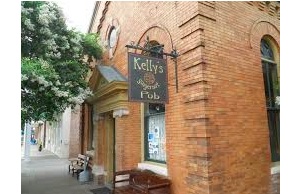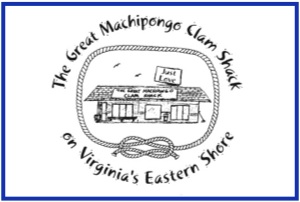PETA Breaks Silence after Killing Parksley Pet
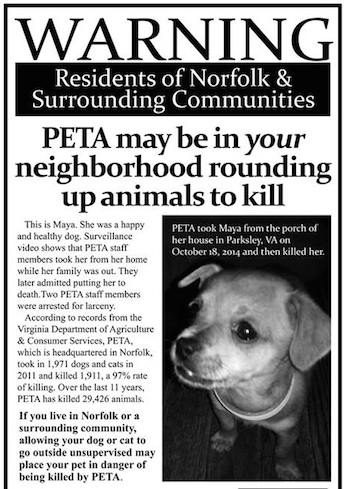
Example of a citizens group’s reaction to PETA’s kidnapping and killing of Maya, a pet chihuahua belonging to a young Parksley girl.
COMPILED FROM NEWS SOURCES
February 27, 2014
When PETA (People for the Ethical Treatment of Animals) workers removed a Parksley child’s pet from the porch of her home on October 18, 2014, and euthanized the dog the next day, the news travelled around the world. It was certainly the biggest story of the year coming out of Virginia’s Eastern Shore.
But perhaps the most surprising element of the story was that PETA, a large, international organization, gave no response whatsoever. Even as citizens groups demonstrated in Accomack County against Commonwealth’s Attorney Gary Agar for his refusal to press charges, PETA remained mum. Only now, more than four months later, has PETA broken its silence and offered an explanation for what happened.
Although Parksley falls outside the Wave’s area of news coverage, the story is so remarkable that we are reprinting portions of an interview with a PETA spokesperson appearing in today’s Virginian-Pilot. Tim Eberly reports from Norfolk that just as a state investigation “is about to become public record, [PETA] is breaking its silence on the bizarre ordeal. It’s our fault, the agency acknowledges. We’re very sorry. And we’ll do whatever it takes to keep it from happening again.” [Read more…]
BEACH PHOTOS: The Agony and the Ecstasy
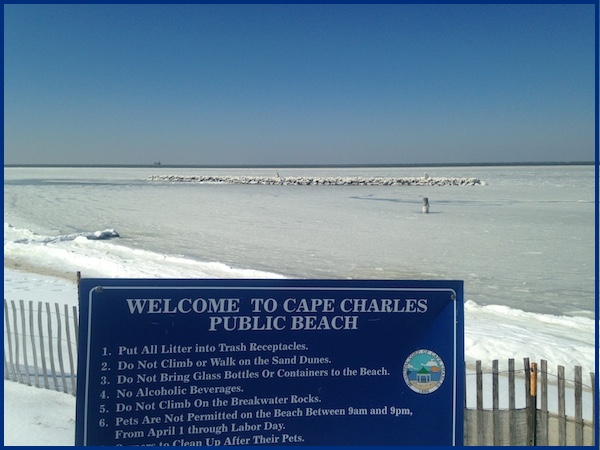

Reader submissions on the coldest, snowiest week of the year include the stark reality of the Cape Charles beach, documented by Frank Wendell, and a fantasy of sugarplums dancing through the head of Gertraud Fendler and her Photoshop. (Published February 23, 2015)
TOWN COUNCIL
Steve Bennett Loses Showdown Over Parking
By WAYNE CREED
Cape Charles Wave
February 23, 2015
With sidewalks frozen and iced over, temperatures dipping into the teens, and winds gusting to 30 knots, the Cape Charles Town Council put on their parkas and braved the elements to conduct the February 18 Regular Meeting at the Civic Center. With normal walkway entrances flooded and crusted over with a thin layer of ice, Chief Pruitt and Jeb Brady had to be on hand to help attendees traverse a makeshift path through the snowbank up to the sidewalk.
Mayor Proto called the meeting to order, and as first order of business, requested a motion to amend the agenda, tabling discussion and vote on the Manhole Rehabilitation Project, and substituting the purchase of property on Mason Avenue. The motion was approved by unanimous vote.
Several items were set to be addressed as new business, but because bids for the manhole project only came in that afternoon, the Town did not have adequate time to review them, and thus produce an accurate number of just how much the work was going to cost. Given this uncertainty, items such as Harbor for the Arts Festival Marketing, Tourism Map, Pine Street Lot Trash Management area, and Beach Swimming Area Safety Measures (Buoys, markers, signage) were put on hold. Council did approve $11,000 for Compensation Study Implementation (due March 1), $10,000 for Leased Parking Area improvements, and then began the discussion of using $70,000 to purchase a lot that currently is part of Patrick Hand’s Strawberry Street Plaza.
When Mr. Hand purchased the old Be-Lo market, he acquired both sets of parking lots that for so many years accommodated overflow for Palace Theatre and Stage Door Gallery events as well as providing convenient access to Mason Avenue restaurants and shops such as Breezes Day Spa, Sea Glass and Stories, Drizzles, and the Cape Charles Coffee House. Purchasing the lot from Mr. Hand, which could be converted into parking, seemed like a definitive win for the Town, destined for a quick, unanimous vote. Instead, Councilman Steve Bennett attacked the logic and timing of the motion. “Strawberry Street is just not important. I don’t think it is a wise investment of taxpayer dollars,” he said. Councilwoman Joan Natali countered, “But we need this to secure parking.”
Councilman Frank Wendell then addressed the Council. “How can visitors access the town without parking? Here, Council seems happy to pay hundreds of thousands to run a pipe (PSA) out to the highway to promote investment there, yet turns a blind eye to the consumers and shops on Mason Avenue.” [Read more…]
WAYNE CREED Pays a Visit to United Poultry Concerns
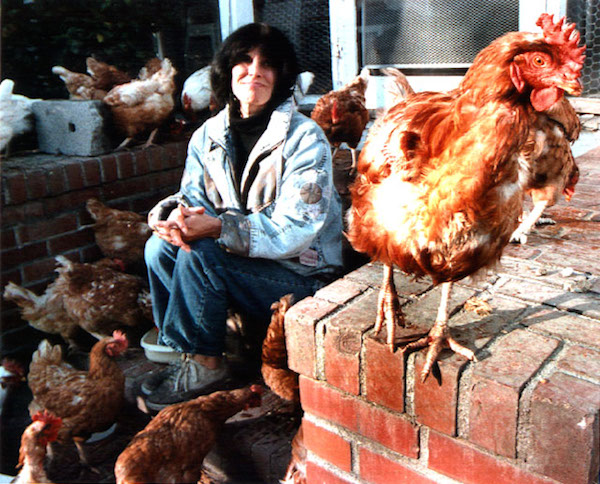
Karen Davis with some of her brood at United Poultry Concerns on Seaside Road. (Photo: Washington Post)
By WAYNE CREED
Cape Charles Wave
February 23, 2015
My roots are in the clay hills of northeastern Alabama, where for generations my forebears were basically subsistence farmers living on what the land would provide them. Mainly corn, cotton, apricots, and other rotational crops were supplemented with eggs (chickens produced year round). A flock of 100-120 chickens lived outside during the day, pecking the dirt for worms and insects, and in the evening returned to the safety of a fairly large corrugated metal and wire chicken house enclosure. This somewhat bucolic memory allowed me for so many years to perpetuate the myth of “cage free” or “free range” organic chicken farming in my own mind.
I would argue for the promotion of “organic” family chicken farming in Washington, DC, and Northern Virginia (where I lived for 25 years), as well as for expanded operations here on the Eastern Shore. That all changed a year ago. As I was traveling to work in Norfolk, I got behind a truckload of caged chickens. The thermometer in my car registered 18 degrees, and as I stopped at a traffic light, I could see each face, crammed in and waiting. I have never been much of an adherer to James Joycean epiphanies, but this was one. It was a realization that I had been very wrong about the myth of the family farm and the possibility of “humane” chicken farming. No matter what justification I tried to use, Morrisey was right: meat is murder — it’s unnecessary and just not possible to farm animals humanely. The end of the line would eventually lead to a cage in the back of a truck. I told myself I would try to no longer be party to this.
Almost one year later, I find myself on another cold morning traveling Seaside Road on the way to the chicken sanctuary and headquarters of United Poultry Concerns. Karen Davis, PhD, is the president of UPC, which she founded in 1990. UPC is a nonprofit organization “dedicated to the compassionate and respectful treatment of domestic fowl” and addresses the treatment of domestic fowl in “food production, science, education, entertainment, and human companionship situations.” [Read more…]
PHOTO: (Not) Sittin’ on the Dock of the Bay
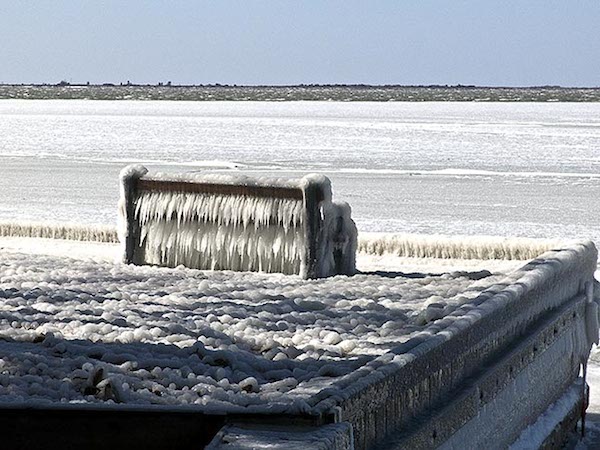
Intrepid photographer Gertraud Fendler documents how the Bay looked yesterday (Sunday, February 15) at 15 degrees in the morning with wind gusts up to 50 mph. An icicle-covered bench will have to wait a long time for a customer.
BOARD OF SUPERVISORS MEETING
Teachers Moonlight to Feed Families
By WAYNE CREED
Cape Charles Wave
February 16, 2015
With temperatures dipping into the low 30s, and with whipping winds over 40 knots, many folks still braved the harsh elements to attend the February 10 Regular Meeting of the Northampton Board of Supervisors. The room was close to capacity, with the entire back section filled with educators and others that support the mission of our county schools. This evening would introduce the year’s budget request from all aspects of county government; those who came to support schools were there to send a message to the Board. Most were wearing translucent blue ribbons, meant to symbolize unity and support for our teachers, as well as invoking a message of transparency in the coming budget process.
During the citizen information period, Occohonack math teacher Justin Wheeler (also Northampton president of local NEA), passionately addressed the BOS, saying that even as teachers work in a field that will have the most impact socially and fiscally (work that many consider the most vital to the County’s future), they are hardly compensated in a way that matches their contributions.
Wheeler freely offered his own pay stub, and ran down his monthly expenses. After tallying them up, his budget was not balanced. In order to make ends meet, he has to work a second job (most teachers find themselves in the same position).
Wheeler went on to say, “Even as our workload is up, a testament to our dedication is that our schools in Northampton are now accredited.”
Leslie James, 4th and 5th grade science teacher at Occohonack, pleaded with the Board to hire another science teacher, which would relieve some of the pressure caused by teaching to the SOLs, and would allow them to truly focus on the subject matter.
Etta Robbins, a 40 year veteran of our schools, requested that the BOS do what they can to replace the high school and the middle school. “We can’t compete with other areas like Northern Virginia and Virginia Beach” until we upgrade our facilities. She, like most educators in the room, also urged the board to raise teacher salaries: “We need to find a way to keep our teachers here. Just last year, we lost four of our best teachers.”
Discussion then turned to the proposed county zoning, and a critique of the county’s “Citizen Information Paper.” Ken Dufty of Exmore attacked the paper, saying, “It fails miserably” in helping citizens really understand what the intentions of the new zoning really are, and in fact, “misleads and misinforms.” Dufty took issue with the proposed uses and the way they were portrayed in the paper. Even as the paper listed more innocuous uses, such as “art studios, kennels, schools,” a closer look at the actual “Draft Proposal” document revealed things such as “prisons, dredge spoil sites, mining excavation sources,” which Dufty called “a blatant attempt to mislead.” Dufty also criticized the removal of the Town Edge District, stating that once most of the Town Edge went back to agriculture, it would open the county up to a number of invasive uses (that he mentioned above). [Read more…]
LETTER: Animal Compassion Is More than Just Pets
February 16, 2015
DEAR EDITOR,
I read Wayne Creed’s article (“Animal Abuse, Theft Highlight Longtime Problems”) with great interest, being aware of the minimal care frequently afforded companion animals by their owners on the Eastern Shore. Friends who moved to Accomack three years ago were so distressed by the harsh treatment of dogs and other animals they observed in many yards that they started providing straw bedding, food and education, even doing repairs in some instances.
Their experience was that while some of the pet owners they helped were happy to receive the purchases and labor, it did not appear they would follow up on their own. Last time we talked, my friends said they had to step back from the toll the situation was taking on their own mental health and resources.
But it isn’t only dogs and cats who suffer from abuse and neglect on the Eastern Shore (and in other parts of Virginia). Chickens and many other animals suffer through every phase of their existence as a result of their status as agricultural animals.
Many of those who abuse and neglect their companion animals work in animal agribusiness where a total lack of compassion for animals, even pleasure in watching them suffer, prevails. People who spend their days being violent toward chickens and other farmed animals as part of their job often bring the violent culture of their employment home with them.
How many residents know that a Virginia statute titled “Care of Agricultural Animals by Owner” (Section 3.2-6503.1) allows the owners of agricultural animals to deprive their animals of food and water up to the point of starvation and dehydration and exempts the owners from providing bedding or shelter, regardless of the weather, for their animals? [Read more…]
Flood Insurance Going Down — But for How Long?
By WAYNE CREED
Cape Charles Wave
February 16, 2015
Historically, the towns of the Eastern Shore have been thought to be at risk from flooding. Flood insurance has always been scarce, and in the 1920s, since it was deemed unprofitable, the insurance industry basically dropped flood insurance (even when it was available, it was too high to attract customers that lived in flood plains).
In the 1960s, Congress began to feel that the way the country was dealing with natural disasters such as floods was expensive and inefficient. They felt that Federal flood programs were funded by all taxpayers, but only benefitted those that lived in flood plains, and who, even after experiencing disaster, would continue to live and build there. In 1968, Congress passed the National Flood Insurance Act which sought to move the costs of flood losses from taxpayers to the actual property owners that lived in flood plains.
The method chosen was to provide flood insurance premiums to flood plain residents. Congress attempted to try and influence development away from risky flood hazard areas, and required that new buildings be built to minimize flood damage.The Federal Insurance Administration (which at that time was in the Department of Housing and Urban Development) was in charge of the program.
Still, participation was weak, and few communities joined the program. In 1972, when hurricane Agnes ravaged the east coast, it was discovered that only 100,000 homes had the insurance. This led to the Flood Disaster Protection Act of 1973, which required that buildings located in identified flood hazard areas must have “flood insurance coverage as a condition of federal aid or loans from federally insured banks and savings and loans and as a condition for receiving federal disaster.” This worked, as more than 2 million polices soon went into effect.
In 1979, the Federal Emergency Management Agency took over the program. FEMA created a floodplain map and developed flood hazard data allowing areas to use them as a structural basis for regulating construction in areas that are prone to flooding. The first version was called the Flood Hazard Boundary Map. However, most places had their FHBM replaced by a Flood Insurance Rate Map, which usually has flood elevations and other flood hazard data.
Effective May 18, 2015, the updated version of the FEMA Flood Insurance Rate Maps will be in place. Due to the updated maps, Cape Charles must adopt an updated Flood Plain Ordinance by March 2, 2015, and submit it to the FEMA Regional Office. For most of us living in Cape Charles, we have become very familiar FEMA flood insurance, and our own Flood Insurance Rate Map. [Read more…]
COMMENTARY
Eastern Shore ‘Too Special to Drill’? –Nope

EXHIBIT A: The Chesapeake Bay at Cape Charles.
By JAY FORD
Virginia Eastern Shorekeeper
February 16, 2015
As part of the Administration’s announcement of new leases for offshore drilling, Secretary of the Interior Sally Jewell continually stated, “Some places are too special to drill.” Apparently, Virginia and the Eastern Shore didn’t make the cut.
Virginia’s Eastern Shore is the largest remaining stretch of coastal wilderness on the entire eastern seaboard of the United States. Additionally, the Eastern Shore has been recognized by the United Nations as an International Biosphere Reserve, and as a Western Hemisphere Shorebird Network Site. There is no place on earth like Virginia’s Eastern Shore; the very definition of special.
Less than five years since the BP disaster overwhelmed the Gulf Coast, our leaders are ready to open our region to the same risks. Our culture, our economy, and our quality of life are inextricably linked to the waters of the Atlantic and the Chesapeake Bay. Our booming aquaculture industry, fisheries, and tourism all depend on clean waters and are susceptible to the slightest changes. Even if we never had a major spill we would have tarballs on our beaches, and drilling fluid, toxic metals, and metal shavings in our ocean as part of the standard operating practice for an offshore rig.
If a spill were to occur, our very way of life on Virginia’s Eastern Shore would be forever altered. Researchers on the Gulf Coast are still trying to quantify the long term damage done to that region’s ecology as a result of oil and the subsequent dispersants. Mutations, deformed hearts, lesions, and sterility have been documented in staggering numbers throughout the fish population. Corals were wiped out, taking with them millenniums old ecosystems. Shrimp with no eyes and/or eye sockets were reported. Petroleum products and oil dispersant has been found in the shells of blue crab larvae and pelican eggs. When asked to put a dollar figure on the ecological damage many researchers had but one answer: “Priceless.” [Read more…]
Local SPCA Needs Community Support

A Cape Charles family poses with their SPCA bundle of Joy: Brendan, Reegan, Penny the beagle, Erilyn, and mom Kathryn.
By WAYNE CREED
Cape Charles Wave
February 16, 2015
The Shore SPCA was founded in 1970, and began its mission here by providing the shelter used for Animal Control Operations. During the past decade, SPCAs around the state were re-evaluating their operations and returning to their roots by providing food, shelter, and medical care to homeless pets and attempting to find them homes. In 2005, the Shore SPCA Board decided to take on that mission and became a no-kill limited intake shelter. Currently, Shore SPCA shelters, treats, rehabilitates, and finds homes for household companion animals in hopes of reducing some of the burden on the Regional Animal Shelter in Accomack.
Although sheltering and adoption are a key function, the need for affordable spay/neuter services as a humane way to manage the overall population is also a big concern. According to Maureen Lawrence, president of the Shore SPCA, since 2008, “we have raised close to $95,000” which went toward a low cost spay/neuter program aimed at lower-income residents. Much of this came in the form of grants ($2,500) from Accomack and Northampton counties. These funds allowed them to qualify for a matching grant. Since then, they have been able to spay or neuter 375 dogs, 990 cats, as well as 502 feral cats. The cost for the surgeries was a low $25 for dogs, and $15 for cats.
As successful as this may sound, as many non-profit organizations will testify, funds from government and foundations have become very hard to come by. Things are beginning to look up, but due to the downturn of the last few years, funds for the spay/neuter program have become so low that the program has had to be temporarily suspended. Ms. Lawrence asserts, “Foundations are increasingly reluctant” to fund spay/neuter programs “without buy-in from the community” and unless they can show a means to sustain the program.
Ms. Lawrence remains optimistic, “We’ve asked Northampton for $3,500, and Accomack for $9,000.” The hope is to amass $12,500, hoping to get a matching grant.
It takes close to $25,000 per year to operate a program that services 500 animals. There has been some criticism that the SPCA has not been doing enough relative to gathering funds, as well as leveraging more from the volunteer community. Ms. Lawrence understands the criticism, and admits the last few years have been tough (not just for the SPCA), but adds that they are constantly re-evaluating the process. “The good news is we have a wonderful grant writer” that will be working hard to get the program back to where it was. [Read more…]
Cape Charles Rotary Computers for Boys and Girls Club

At the check presentation ceremony: Bill Payne, Eastern Shore Boys and Girls Club Chairman and Kathy Custis, Executive Director, with John Burdiss, Cape Charles Rotary past president, and Allan Burns, current president.
February marks the beginning of a special new partnership between the Rotary Club of Cape Charles and the Eastern Shore Boys and Girls Club. The Rotary Club will bring much-needed technology and career mentorship to local youth in order to provide the teens a jumpstart on successful careers. The first step is a grant of $4,000 to the local Boys and Girls Club.In addition to the grant, Cape Charles Rotary will conduct a Career Day for the Eastern Shore Boys and Girls Club at Occohannock Elementary School February 21 from 9:30 a.m. until 1:30 p.m. According to Kathy Custis, Executive Director of the Eastern Shore Boys and Girls Club, “This generous grant will be used to purchase computers in support of the upcoming Career Day and various other Boys and Girls Club programs. We are so grateful that this will be an ongoing relationship with the Cape Charles Rotary Club.” [Read more…]




